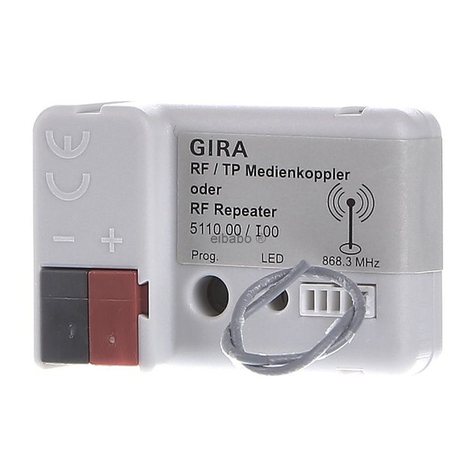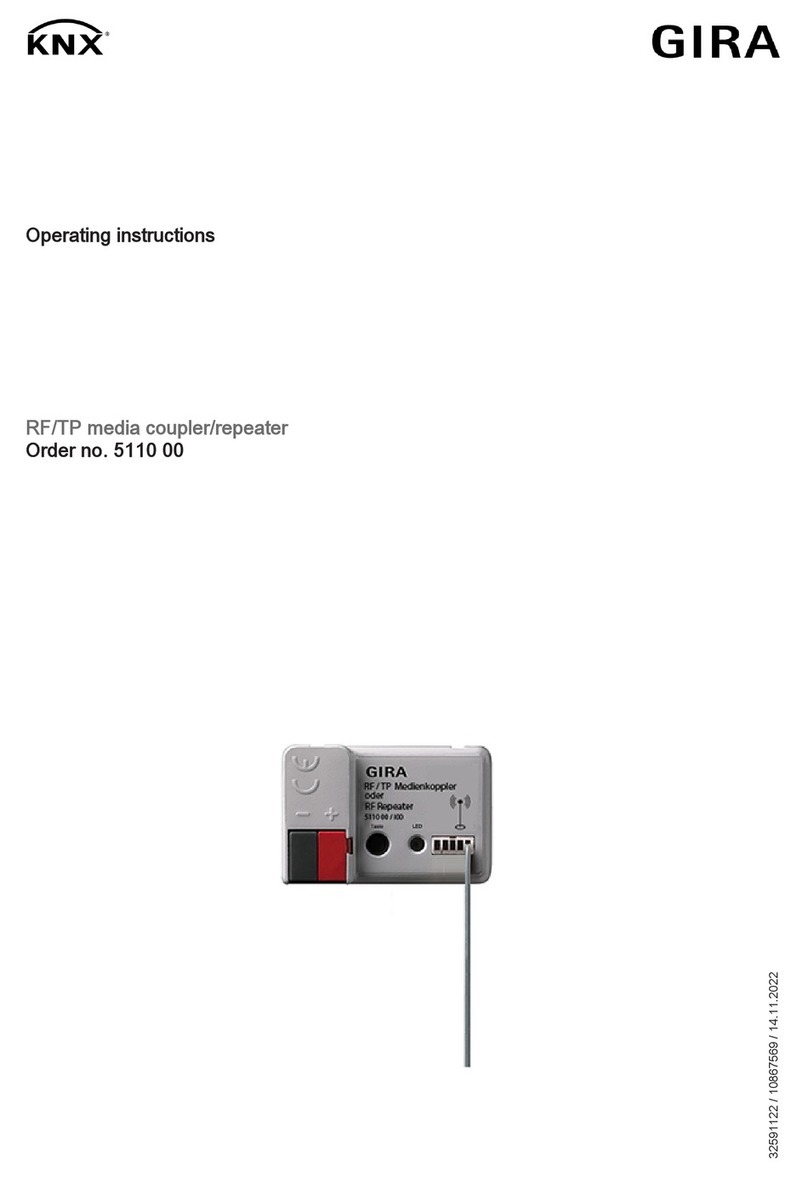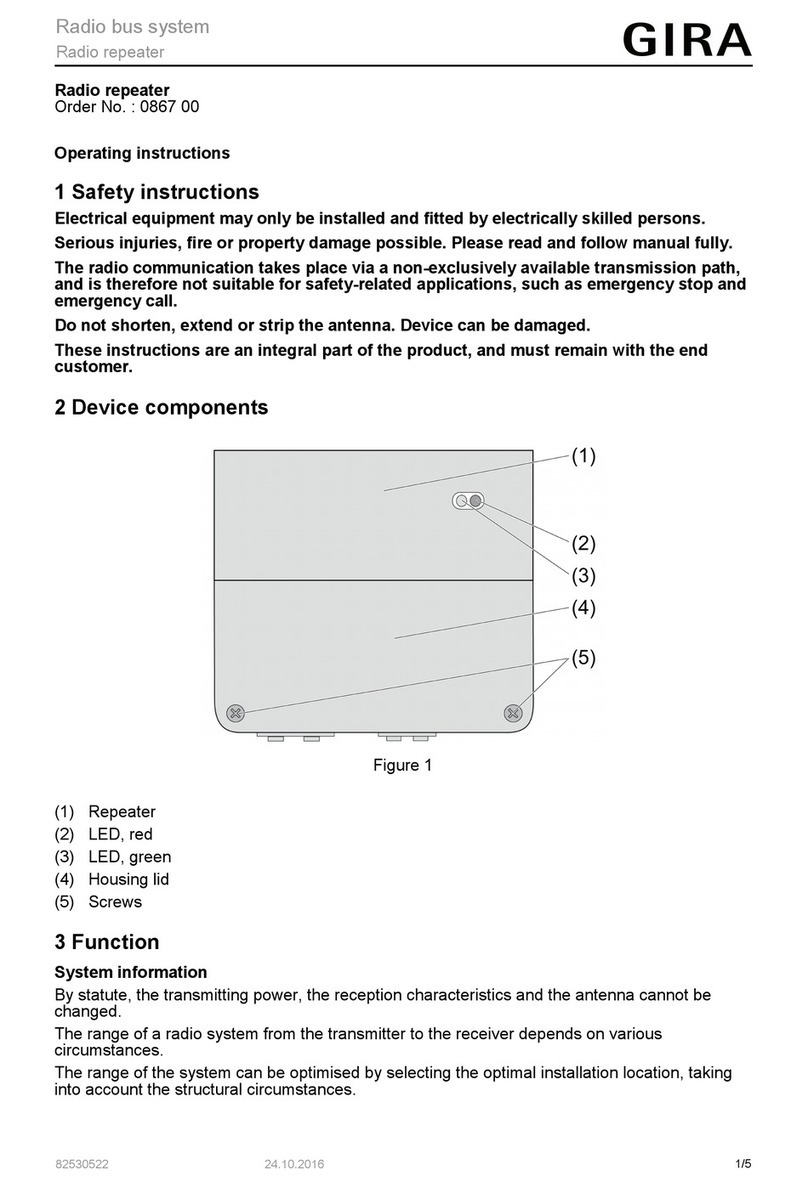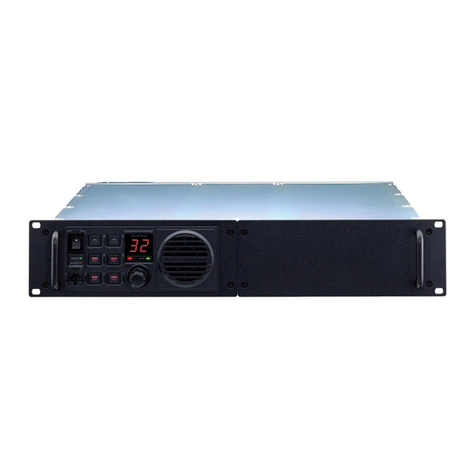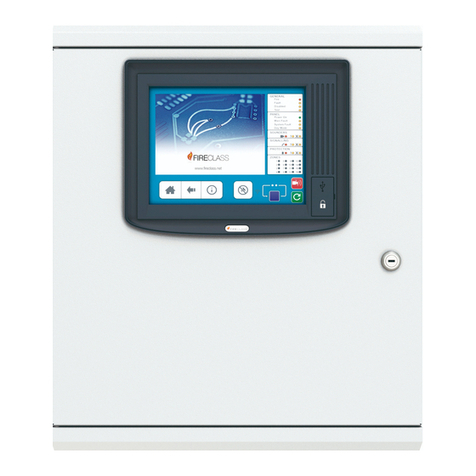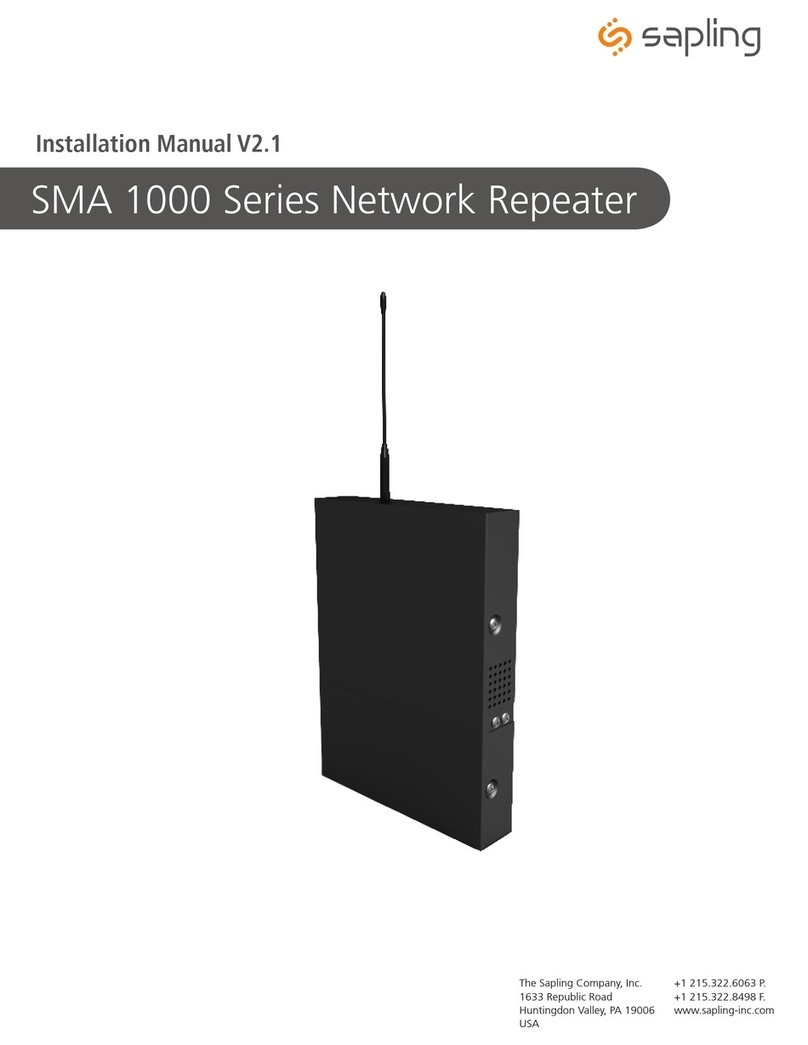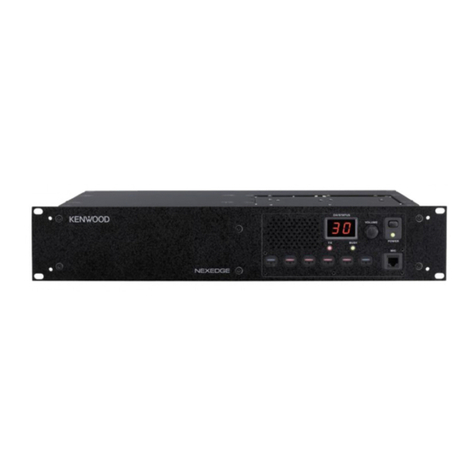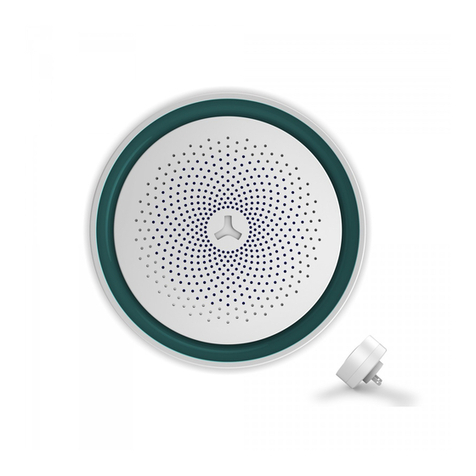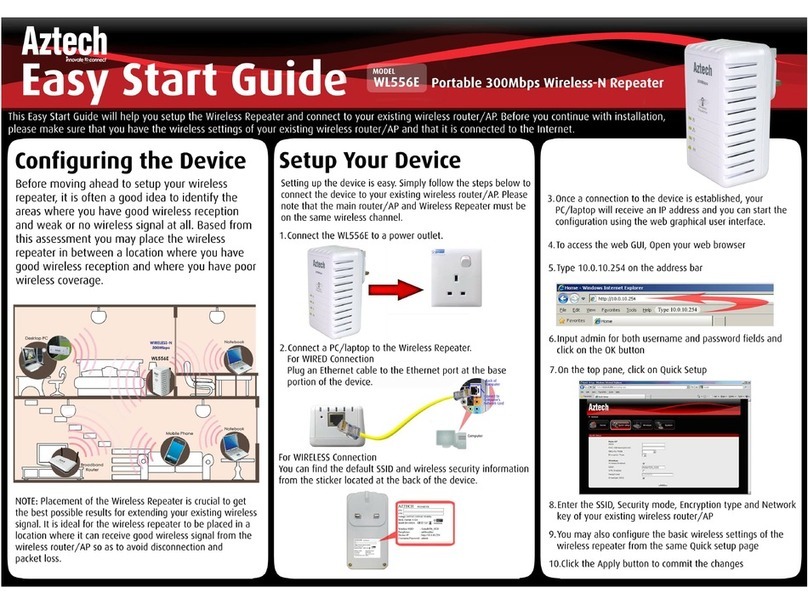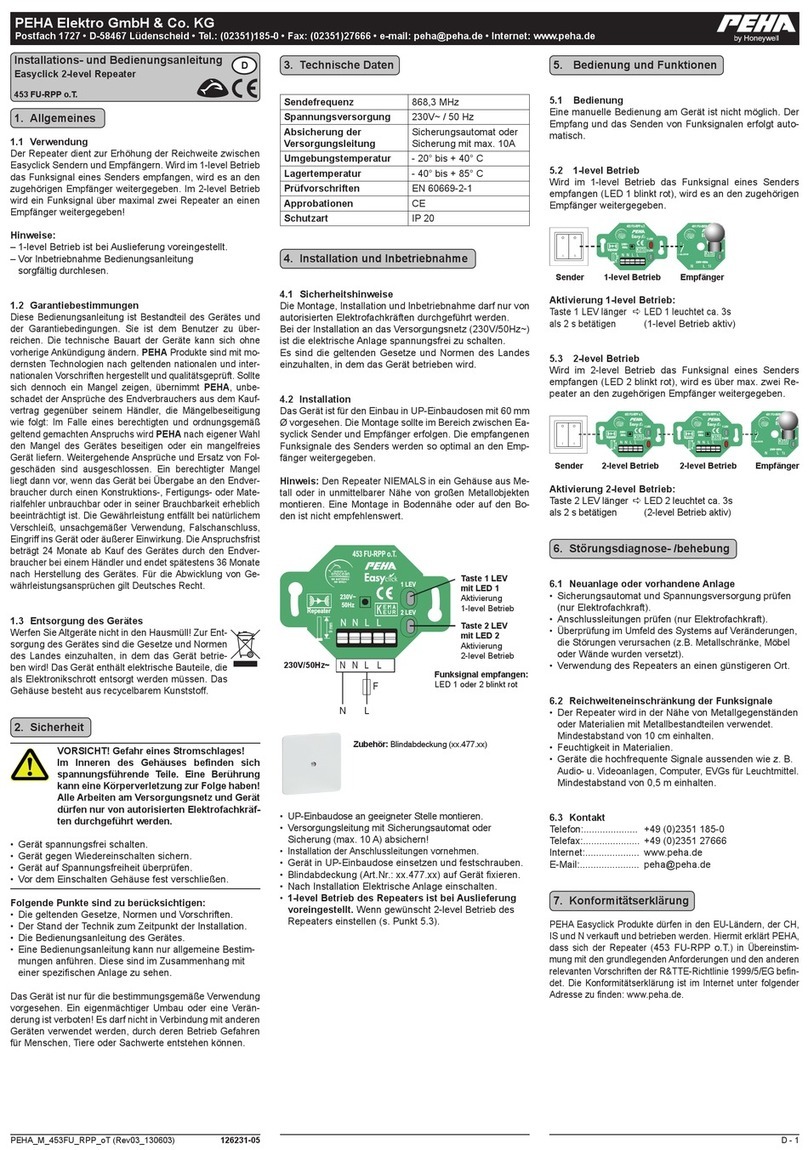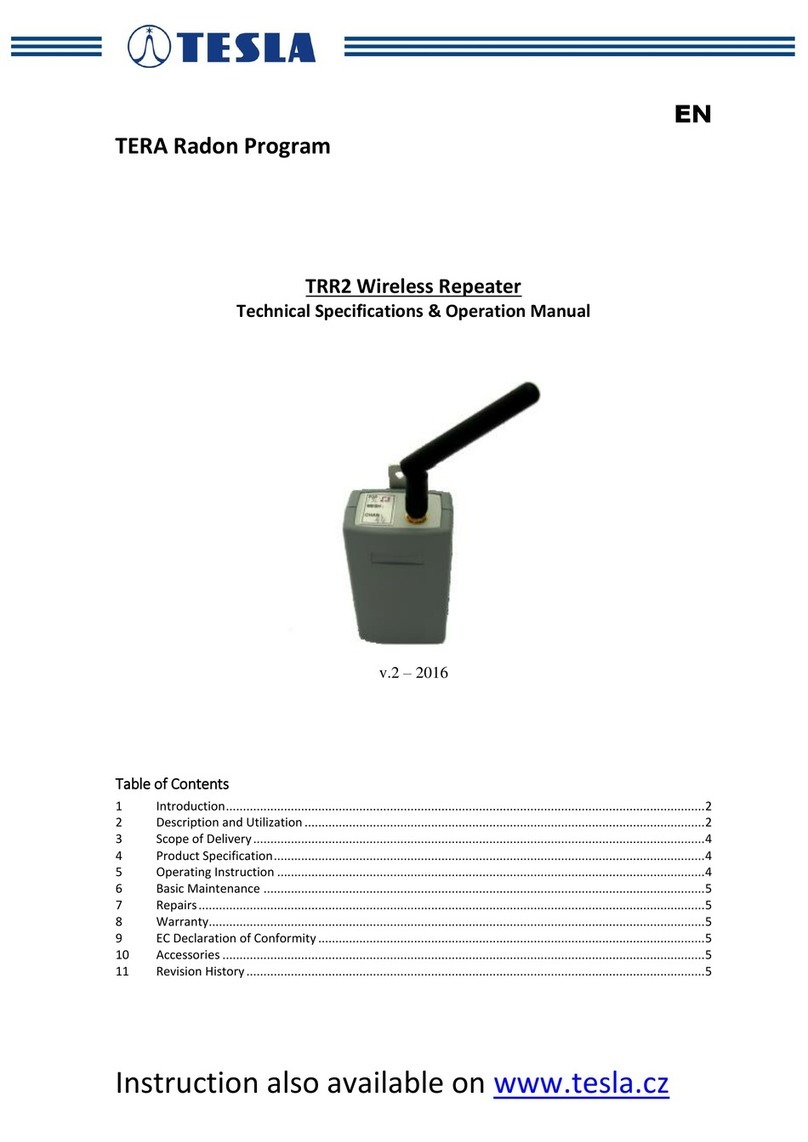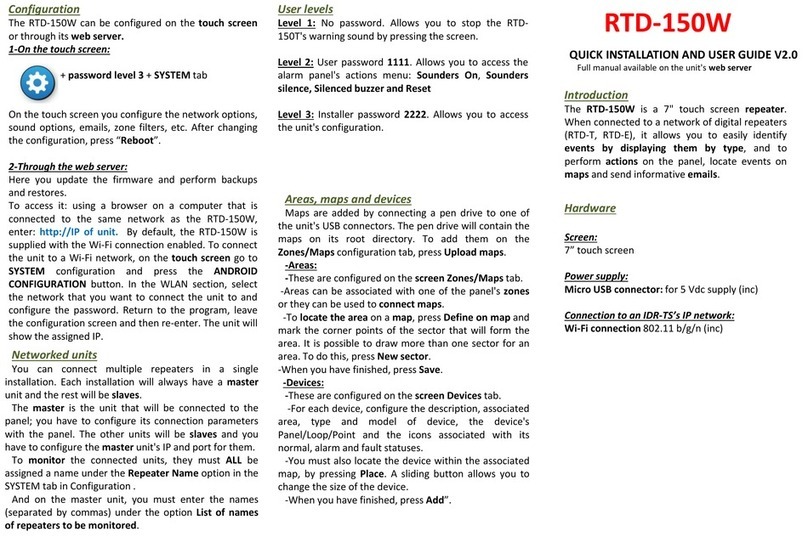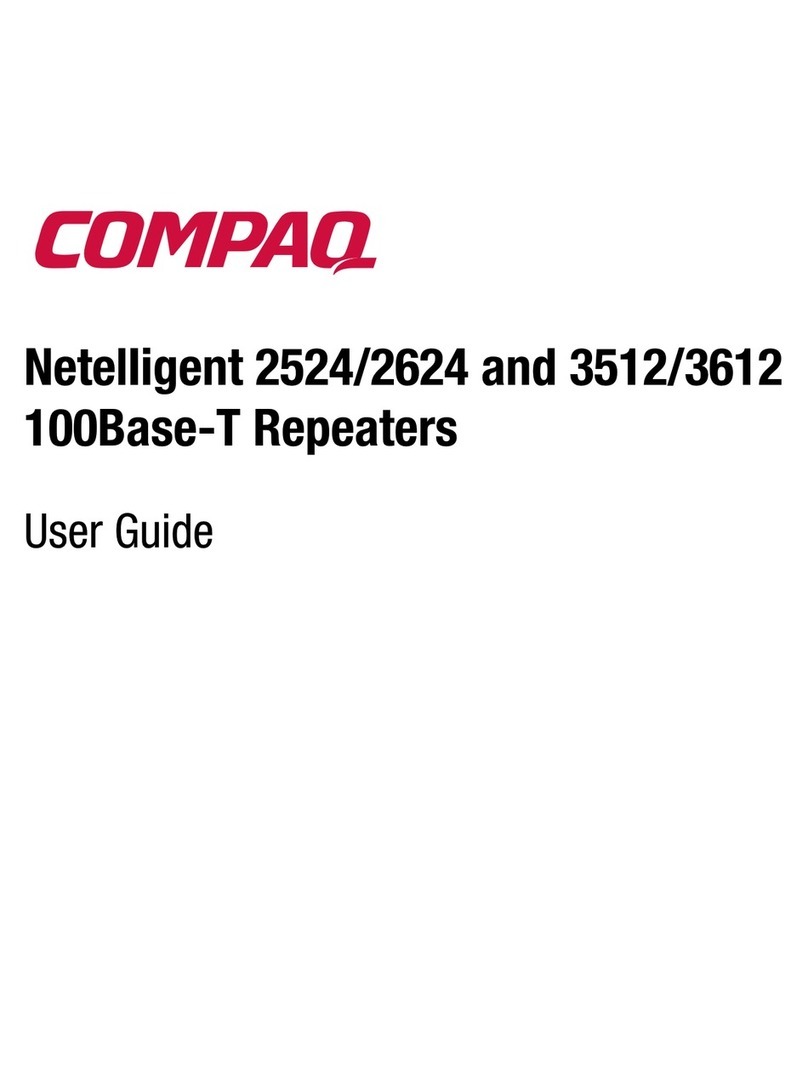Gira 5110 00 Operator's manual

Product documentation
Issue:
22.03.2016
RF/TP media coupler or RF repeater
Order No. 5110 00
10863581

Order No. 5110 00
Table of Contents
Product definition1 3.................................................................................................................
Product catalogue1.1 3...........................................................................................................
Function1.2 3..........................................................................................................................
Accessories1.3 4.....................................................................................................................
Installation, electrical connection and operation2 5..............................................................
Safety instructions2.1 5...........................................................................................................
Device components2.2 6........................................................................................................
Mounting and electrical connection2.3 7.................................................................................
Commissioning2.4 9...............................................................................................................
Technical data3 11....................................................................................................................
Software description4 12..........................................................................................................
Software specification4.1 12...................................................................................................
Software "Media coupler / repeater"4.2 13.............................................................................
Scope of functions4.2.1 13.................................................................................................
Notes on software4.2.2 14..................................................................................................
Functional description4.2.3 15............................................................................................
Function as media coupler4.2.3.1 15.............................................................................
Function as repeater4.2.3.2 19......................................................................................
LED display4.2.3.3 23....................................................................................................
Configuration lock4.2.3.4 24..........................................................................................
Safe-state mode4.2.3.5 25.............................................................................................
Delivery state4.2.3.6 27.................................................................................................
Parameters4.2.4 28............................................................................................................
Appendix5 35.............................................................................................................................
The KNX RF system5.1 35.....................................................................................................
Basic physical principles5.2 39...............................................................................................
Building structure and RF topology5.3 46...............................................................................
Index6 56....................................................................................................................................
Product documentation
Page 2 of 57

Order No. 5110 00
1 Product definition
1.1 Product catalogue
Product name: RF/TP media coupler or RF repeater
Use: System device
Design: Installation
Order No. 5110 00
1.2 Function
Media couplers are the link between a specific KNX RF environment (RF = Radio Frequency)
and a wired KNX TP installation (TP = Twisted Pair). With regard to the routing property of
telegrams, media couplers function like standard TP backbone/line couplers. This means that
RF devices can communicate with TP devices via a media coupler or (with additional IP area
couplers) with IP devices and vice versa.
Media couplers possess filter settings and filter tables. The physical address defines whether a
media coupler is a line coupler or a backbone coupler. The exact function of the device is
determined by the selected parameterization and by the physical address.
Optionally, the Gira media coupler can additionally or alternatively work as an repeater. A
repeater repeats the radio telegrams received in its RF line by retransmitting them immediately.
This allows an extension of the range of a KNX RF installation, meaning that it is possible to
position RF devices as required in a building, even in the case of difficult transmission and
reception conditions.
The Gira media coupler is a device which allows the media type RF on the lower-level line and
the media type TP on the higher-level line. As of version 5, the device can be configured and
commissioned using the ETS. The device is powered via a KNX TP bus connection (KNX power
supply unit) or alternatively, via a suitable external DC power supply unit in repeater operation
(see chapter 1.3. Accessories).
Page 3 of 57
Product definition

Order No. 5110 00
1.3 Accessories
Flush-mounted power supply unit 250 mA Order No. 2969 03
Power supply for door communication 24 V DC
300 mA
Order No. 1296 00
Page 4 of 57
Product definition

Order No. 5110 00
2 Installation, electrical connection and operation
2.1 Safety instructions
Electrical devices may only be mounted and connected by electrically skilled
persons.
Failure to observe the instructions may cause damage to the device and result in fire and
other hazards.
The radio communication takes place via a non-exclusively available transmission path,
and is therefore not suitable for safety-related applications, such as emergency stop and
emergency call.
Page 5 of 57
Installation, electrical connection and operation

Order No. 5110 00
2.2 Device components
Figure 1: Device components media coupler
(1) KNX TP bus connection
(2) Programming button
(3) Status LED
Lights red: Programming mode active
Flashes red quickly: Filter function not configured (filter table has no function)
Flashes red slowly: Safe-state mode active
Flashes yellow: Parameter-dependent (TP or RF telegram forwarding, telegram traffic)
Short change red -> yellow: Display test after a device restart
(4) Antenna
iDo not shorten or extend the antenna (4), or connect it to an electrical potential!
Page 6 of 57
Installation, electrical connection and operation

Order No. 5110 00
2.3 Mounting and electrical connection
DANGER!
Electrical shock on contact with live parts in the installation environment.
Electrical shocks can be fatal.
Before working on the device, disconnect the power supply and cover up live
parts in the working environment.
General
Mount in suitable flush-mounted or surface appliance boxes.
iIn outdoor installations: Use appliance box IP55.
iDo not place the device in small metallic distributors or boxes.
Do not lead any wire or sheathed cables from other power circuits through the appliance box.
Precondition: To ensure good transmission quality, keep a sufficient distance from possible
interference sources, e.g. metallic surfaces, microwave ovens, hi-fi and TV sets, ballasts or
transformers.
Connect the device and mount it for use as media coupler
The media coupler is connected to and supplied by a KNX bus cable (TP).
Precondition: Ideally, the media coupler is positioned in the centre of an RF installation
(domain), to allow low-loss and thus interference-free communication with all the associated RF
devices.
oConnect device to a KNX bus cable. For this, use a KNX device connection terminal.
Ensure correct polarity.
iIf the media coupler is used as a line coupler, the KNX bus cable must be the main line of a
TP area. If the media coupler is used as area coupler, the KNX bus cable must be the TP
area line (Backbone) of the KNX installation.
oPlace the device in the appliance box.
oWhen laying the antenna, extend the antenna extended as much as possible. If this is not
possible, position the antenna behind the device in a circular arrangement.
iWhen using blank covers, make sure the antenna does not lie directly behind the metal
supporting frame.
Connect the device and mount it for use as a repeater (no media coupler function)
If needed, the repeater can be connected to a KNX bus cable (TP) via which it is supplied, as
long as the bus cable is the TP line of the associated media coupler. Thus the use of the
repeater is especially relevant for retroactive solutions in existing TP systems.
Alternatively, a repeater can also be supplied via a separate DC power supply (see
accessories), even without KNX bus voltage.
Precondition: The repeater is positioned within radio range of the media coupler and ideally
within radio range of another repeater of the same RF domain, to allow low-loss and thus
interference-free communication with all the associated RF devices.
oConnect the device to a KNX bus cable or alternatively, to a separate DC power supply.
For this, use a KNX device connection terminal. Ensure correct polarity.
iDo not use the unchoked 30 V output of a KNX power supply! The media coupler may heat
up to an impermissible temperature.
Page 7 of 57
Installation, electrical connection and operation

Order No. 5110 00
iWhen connecting a TP bus cable, after the physical address is programmed, no direct ETS
program access to the device on the TP side during repeater operation is possible any
longer. Consequently, the repeater can only be programmed and diagnosed (e.g. with the
use of suitable KNX RF USB data interfaces or via another media coupler of the same RF
domain) via the RF side.
oPlace the device in the appliance box.
oWhen laying the antenna, extend the antenna extended as much as possible. If this is not
possible, position the antenna behind the device in a circular arrangement.
iWhen using blank covers, make sure the antenna does not lie directly behind the metal
supporting frame.
Page 8 of 57
Installation, electrical connection and operation

Order No. 5110 00
2.4 Commissioning
General
Depending on the physical address, the device can be added to the KNX topology either as a
media coupler or alternatively, as an RF repeater, and commissioned. Already the physical
address assignment and programming define the device function.
The device operates as a media coupler when it is given a physical address in the form
x.y.0 (line coupler) or x.0.0 (area coupler) (x = area address, y = line address).
The device operates exclusively as a repeater when it is assigned a physical address in the
form x.y.1...255.
In an RF domain, always commission the media coupler first! Only then should any optional
additional repeaters and all other participants of the RF installation be programmed.
Ideally, install and connect the repeater after the media coupler has been completely
commissioned.
Precondition: An appropriate device must be created and configured in the ETS project. Device
has been connected and the power is switched off.
iProject design and commissioning with ETS5 or a more recent version.
iProgramming mode is deactivated after the physical address has been successfully
programmed, or is generally deactivated by a device test (power failure, ETS programming
process of the application program).
Programming mode is also deactivated automatically after 4 minutes if none of the above
events occurs.
Commissioning as media coupler
As delivered, the device can be programmed and commissioned as a media coupler via the TP
side (e.g. with the use of suitable USB or IP data interfaces) or via the RF side (e.g. with a KNX
RF USB data interface).
iAfter a successful initial commissioning, access to the device for programming may be
restricted because of an active configuration lock (see page 24).
oPress the programming button (2)(Figure 1).
The status LED (3) lights up red. Programming mode is activated.
oLoad the physical address into the device. The ETS also automatically loads the domain
address of the RF line into the device.
The red status LED goes out.
iWhen programming the media coupler via RF: For the programming of the physical
address and the domain address to be carried out and completed correctly, the domain
address of the RF line must match the domain address of the RF communication interface
(e.g. KNX USB RF data interface)! Otherwise, communication errors can be expected.
The domain address of the KNX RF USB data interface used by the ETS is configured in
the general connection settings of the ETS. In an ETS project, the domain address of an
RF line or a media coupler is configured in the line properties (separate for each RF line).
oLoad the application program into the device using the ETS.
iThe filter table is automatically loaded to the device together with the application program
via the ETS. Whether or not the filter table is used for routing group telegrams in media
coupler operation is defined by the device parameters.
In pure repeater operation, the filter table has no function.
Commissioning the device as a repeater
The device can only be programmed as a pure repeater (no media coupler function) and
commissioned via the TP side to a limited extent (e.g. with the use of suitable USB or IP data
interfaces, if the device is connected to the TP line of the associated media coupler).
Page 9 of 57
Installation, electrical connection and operation

Order No. 5110 00
Programming access to the device via the RF side is always possible with no limitation (e.g.
with a KNX RF USB data interface or via a media coupler).
After the physical address is programmed, a repeater can no longer be reached directly via the
TP side. As a result, further programming operations using the ETS can no longer be executed
on the TP side without the media coupler. Direct access to the device via the TP side is only
possible again when the device is reset to delivery state (see page 27).
Program the physical address and the application program always separately.
oPress the programming button (2)(Figure 1).
The status LED (3) lights up red. Programming mode is activated.
oLoad the Physical Address to the device via the TP side (if the device is connected to the
TP line of the associated media coupler) or the RF side. The ETS also automatically loads
the domain address of the RF line into the device.
The red status LED goes out.
iAfter the physical address has been successfully programmed, the device can no longer be
reached with the ETS via the TP side, because the device's TP transponder is switched off!
This feature is necessary because from a topological standpoint, a repeater (without media
coupler function) is exclusively assigned to the RF line, and no longer to a TP line.
Consequently, afterwards the application program can only be programmed separately via
the RF side. To do so, either a programming connection via the media coupler of the RF
domain can be used (TP -> RF) or alternatively, a KNX RF USB data interface.
Where necessary, the TP line of the media coupler can be used for power supply to the
repeater (see page 7-8).
iWhen programming the repeater via RF: For the programming of the physical address and
the domain address to be carried out and completed correctly, the domain address of the
RF line must match the domain address of the RF communication interface (e.g. KNX USB
RF data interface)! Otherwise, communication errors can be expected.
The domain address of the KNX RF USB data interface used by the ETS is configured in
the general connection settings of the ETS. In an ETS project, the domain address of an
RF line or a repeater is configured in the line properties (separate for each RF line).
oLoad the application program into the device using the ETS.
iIn pure repeater operation, the filter table has no function.
Page 10 of 57
Installation, electrical connection and operation

Order No. 5110 00
3 Technical data
General
Test mark KNX
Ambient temperature -20 ... +55°C
Storage temperature -25 ... +45°C
Transport temperature -25 ... +70°C
Degree of protection IP 20
Protection class III
Dimensions L×W×H 44x29x16 mm
Relative humidity 10 ... 100% (No moisture condensation)
KNX RF
KNX medium RF1.R
Commissioning mode S-mode
Radio frequency 868.0 ... 868.6MHz
Transmitting power max. 20mW
Transmitting range in free field typ. 100m
KNX TP
KNX medium TP
Commissioning mode S-mode
Rated voltage KNX DC 21 ... 32VSELV
Current consumption KNX max. 5mA
Repeater operation
Rated voltage DC 24VSELV
Data according to EN 300220
Receiver category 2
Page 11 of 57
Technical data

Order No. 5110 00
4 Software description
4.1 Software specification
ETS search paths: - Radio / System components / RF/TP media coupler or RF
repeater
Configuration: S-mode standard
Application:
No. Short description Name Version from mask
version
1 Use as media coupler in the function of
area or line coupler (depending on the
physical address and configuration).
Use as KNX RF repeater possible.
Media coupler /
repeater 902011
1.1 2920
Page 12 of 57
Software specification

Order No. 5110 00
4.2 Software "Media coupler / repeater"
4.2.1 Scope of functions
- Use as media coupler in the function of area or line coupler (depending on the physical
address)
- Use as KNX RF repeater possible
- Influence on forwarding of group telegrams (routing) by filter function in coupler operation
- Support of the full address range (groups 0-31) for filter function
- Forwarding of group telegrams (TP -> RF, RF -> TP) parameterizable
- Forwarding of physically addressed telegrams (TP -> RF, RF -> TP) parameterizable
- Forwarding of broadcast telegrams (TP -> RF, RF -> TP) parameterizable
- Telegram repetitions in case of transmission errors for group, broadcast and physically
addressed telegrams can be set on the TP side
- Telegram confirmation for group and physically addressed telegrams can be separately
configured on the TP side
- Configuration lock can be set (programming only via TP or RF)
- Status LED to display device statuses
- Conversion and generation of RF system broadcast telegrams
- Support of long frames
- Safe-state mode to stop the application program (e.g. if the device does not function
properly due to errors in the project design or during commissioning)
- Function for reset to delivery state
Page 13 of 57
Software "Media coupler / repeater"
Scope of functions

Order No. 5110 00
4.2.2 Notes on software
Restricted ETS programming access in repeater operation
When the device is used as a repeater (physical address = x.y.1...255 / no media coupler
function), take note that after the physical address is programmed, a repeater can no longer be
reached directly via the TP side. As a result, further programming operations using the ETS
(e.g. programming the application program) can no longer be executed on the TP side without
the media coupler.
Direct access to the device via the TP side is only possible again when the device is reset to
delivery state (see page 27).
Page 14 of 57
Software "Media coupler / repeater"
Notes on software

Order No. 5110 00
4.2.3 Functional description
4.2.3.1 Function as media coupler
Line coupler or area coupler
A media coupler, depending on the physical address, can either be added to the KNX topology
as a backbone coupler or, alternatively, as a line coupler. With KNX RF, there is generally no
physical limitation of the number of possible bus subscribers as in a TP line (e.g. 64). With KNX
RF, the number of subscribers is only limited by the physical addresses assigned in the ETS.
- Media coupler as line coupler
The media coupler has a physical address in the form x.y.0 (x = TP area address, x = TP
line address / e.g. "1.1.0").
A KNX RF line can contain up to 256 devices (including media coupler) (Figure 2). The
media coupler is connected to the main TP line of an area. Additional TP lines can be set
up using additional TP line couplers.
iThere may only ever be one media coupler in an RF line. Multiple repeaters can be added
to an RF line.
Figure 2: Example of a possible KNX topology with RF, TP and IP lines
Media coupler as line coupler
MC Media coupler as line coupler (TP, RF)
LC Line coupler (TP)
BC Backbone coupler (as IP router / TP, IP)
PSUPower supply (TP)
Page 15 of 57
Software "Media coupler / repeater"
Functional description

Order No. 5110 00
- Media coupler as backbone coupler
The media coupler has a physical address in the form x.0.0 (x = TP area address / e.g.
"1.0.0").
If a media coupler is used as a backbone coupler, then a total of up to 4,081 RF devices
(including media couplers) can be integrated into the appropriate area. The RF devices
must then divide themselves up on the backbone line and on up to 15 additional
subordinate RF lines (Figure 3). In the ETS, a maximum of 255 subscribers may exist for
each area or line. If the media coupler is a backbone coupler, then the backbone must
possess the media type "TP". A KNX IP environment cannot then be implemented (the ETS
prevents such a topology)!
iEven in an RF area, there may only be one media coupler (subordinate RF lines do not
possess their own media coupler).
iSubordinate RF lines of an RF area always have the same domain address as the area
itself.
Figure 3: Example of a possible KNX topology with RF and TP lines
Media coupler as backbone coupler
MC Media coupler as backbone coupler (TP, RF)
LC Line coupler (TP)
BC Backbone coupler (TP)
PSUPower supply (TP)
Page 16 of 57
Software "Media coupler / repeater"
Functional description

Order No. 5110 00
Different RF domains in one KNX installation
Devices in different RF domains must be topologically divided into two different lines or
backbones, each with their own domain addresses. These different areas or lines must also
contain their own media couplers for the devices to be able to communicate with one another,
irrespective of the line. The logical connection between two or more KNX RF environments is
thus always made via media couplers and higher-level TP or IP lines (Figure 4).
KNX RF USB data interfaces, as used in the ETS, are also assigned to a domain address. In
consequence, only RF devices of the same domain can be commissioned directly by radio
telegram. Only group telegrams and physically addressed telegrams of the appropriate RF
domain are recorded in the group monitor of the ETS (exception: System broadcast telegrams).
If other RF devices of another domain are to be contacted with an RF data interface, then
communication via media couplers is necessary. If the KNX topology is set up correctly, then
such communication takes place automatically via the KNX routing (precondition: media and
backbone/line couplers forward the telegrams according to their filter property).
Figure 4: Example of a possible KNX topology with two RF lines
and coupling via a TP main line (example)
iIn general, multiple media couplers can be used in various lines and areas of a KNX
topology. The ETS permits such a configuration. However, media couplers in a shared
KNX system can influence each other unfavourably. In particular, during the commissioning
of various bus devices using the ETS, radio telegrams may be superimposed, meaning that
radio communication is poor or even impossible. Suitable precautions can be taken to
avoid such a situation (spatial separation of the RF environments, logical filtering of specific
telegrams).
iMedia couplers cannot be used to network two or more KNX installations via RF (no proxy
function)!
Page 17 of 57
Software "Media coupler / repeater"
Functional description

Order No. 5110 00
iRF areas or lines of a joint KNX installation or of directly adjacent KNX installations in radio
range may never have an identical domain address! The ETS offers a function for random
assignment of a domain address for RF lines, in order to avoid this improper situation.
When the random function is used, the probability of multiple assignment of an identical
address is more or less non-existent. A domain address automatically generated by the
ETS is characterised by the hexadecimal characters "00FA..." (e.g. "00FA:4D6C3F58").
Routing counter and telegram repeat counter (expert knowledge)
In a TP telegram, the routing counter identifies how often the telegram has already been
forwarded by the area or line coupler, or the TP line amplifier. The routing counter is a 3-bit
counted measurand (values 0...7) which is reduced by "1" for every forwarding process via the
coupler or line amplifier. As soon as a bus device sends out a new telegram, the routing counter
is given the value "6". Through the permissible KNX topology with area couplers, line couplers
and line amplifiers can, and are permitted to, forward the telegram a maximum of 6 times.
Telegrams for which the routing counter is given the value "0" are no longer forwarded via the
coupler or TP line amplifier.
The routing counter value "7" is a special case which is not used by normal bus devices.
Telegrams with this value are always forwarded. The value is not reduced thereby.
With the KNX RF, the routing counter is replaced by the telegram repeat counter ("RF repeat
counter"). When a transmitter sends a new telegram for the first time, it is given the repeat value
"6". As soon as a repeater receives this telegram and forwards it, the value is reduced by "1".
For each additional repetition process via another repeater in the same RF domain, the repeat
value is again reduced by "1". Once the value is "0", the telegram is no longer repeated. With
this process, an RF telegram can be forwarded through a maximum 6 repeaters in one domain.
Only repeaters are permitted to influence the telegram repeat counter.
During forwarding on the RF side, a media coupler always replaces the routing counter of a
received TP telegram with the telegram repeat counter and the value "6". It is irrelevant which
value the routing counter has.
Likewise, during forwarding on the TP side, the media coupler always replaces the telegram
repeat counter of received RF telegrams with a routing counter and the value "6", regardless of
which value the telegram repeat counter had before.
Telegrams that are forwarded via a media coupler via the TP side to the RF side cannot be
returned to the TP side by any other media coupler. This is prevented by the "Route-Last" flag,
which is set during the forwarding process and forwarded in the RF telegram.
This limitation is important for system broadcast telegrams which are not dependent on any
domain. Therefore a system broadcast generated by a media coupler cannot be mistakenly
returned to the TP side by other media couplers.
Page 18 of 57
Software "Media coupler / repeater"
Functional description

Order No. 5110 00
4.2.3.2 Function as repeater
Media couplers with repeater or repeater alone
The media coupler can work as an repeater (also, "retransmitter") in addition to or as an
alternative to its function as a coupler. A repeater repeats the radio telegrams received in its RF
line by retransmitting them immediately. This allows an extension of the range of a KNX RF
installation, meaning that it is possible to position RF devices as required in a building, even in
the case of difficult transmission and reception conditions.
The device can only work as a media coupler (see page 15), as a media coupler with repeater
or as a repeater alone. The operating mode is defined by the parameter setting and the physical
address. The device is exclusively a repeater when it has a physical address which corresponds
to a normal participant address of the RF line (e.g. x.y.1 or x.y.200 / x = area address, y = line
address).
- Function as media coupler with repeater:
The device has a physical address in the form x.y.0 and works as a media coupler (see
page 15). In addition, the repeater function can be released with the setting "activated" for
the parameter "Repeater function for use as media coupler". The parameter "Physical
address of the device" must be configured to "x.y.0 (media coupler)".
Combined operation of the media coupler and repeater function is helpful if, within a radio
domain, all the RF subscribers are within radio range of the media coupler but are not
however in the radio ranges of other RF subscribers. Here, the repeater integrated in the
central media coupler ensures that telegrams from RF subscribers also actually reach all
the other RF subscribers of the radio domain.
Application example (Figure 5): Because of the spatial distance, no direct communication
between the two RF devices (1.) is possible. The communication route via the media
coupler with repeater function (2.), however, enables communication between the two
devices without interference.
Figure 5: Application example of a media coupler with repeater function
Page 19 of 57
Software "Media coupler / repeater"
Functional description

Order No. 5110 00
iIn combined operation, the repeater function is executed parallel to the media coupler
function (routing). The device acts as if the media coupler and the repeater were two
separate devices in the same housing and shared the same RF transmitter.
iThe integrated repeater does not repeat telegrams which are forwarded to the RF side by
the media coupler function and transmitted there.
- Function as a repeater alone:
The device has a physical address in the form x.y.1...255. In this case, the media coupler
function is completely switched off. The device does not perform any routing and thus does
not have any parameters for configuring filter properties. The parameter "Physical address
of the device" must be configured to "x.y.1...255 (RF repeater)".
The operation of one or more repeaters is recommended when the range of the RF domain
should be deliberately extended in one or more directions (e.g. in trans-property
communication), or when a part of a building (e.g. ceilings, walls, metal constructions)
which weakens the signal need to be overcome.
Repeaters can be positioned around the media coupler in a star formation (Figure 6),
ideally within the radio ranges of other/adjacent repeaters of the same RF domain, or also
oriented in a strand configuration (Figure 7), e.g for overcoming greater distances in a
deliberate direction.
iUsing a maximum 2 repeaters in one RF domain (see application examples) is
recommended to prevent communication problems due to forwarded telegrams.
Communication problems due to forwarded telegrams can occur when repeaters are not
positioned to each other within their own reception area, but still affect identical devices
(e.g. hand-held transmitters) in the same RF domain independently of each other. In this
case, therefore, the radio ranges of the repeaters overlap for some RF devices, but not at
the installation location of the repeater. If only two repeaters are used in one RF domain,
the likelihood of communication problems due to repeated telegrams is reduced.
The ETS permits integration of up to 255 repeaters in one domain. Nonetheless, because
of the RF data protocol, one RF telegram can only be forwarded a maximum of six times.
Thus, use of more than 2 repeaters in one RF domain would be possible in principle.
iAfter the physical address is programmed, a repeater can no longer be reached directly via
the ETS, because the TP transponder of the device is switched off. This feature is
necessary because from a topological standpoint, a repeater (without media coupler
function) is exclusively assigned to the RF line, and no longer to a TP line. As a result,
further programming operations using the ETS can no longer be executed on the TP side
without the media coupler. Direct access to the device via the TP side is only possible
again when the device is reset to delivery state (see page 27).
Further information on commissioning is available in the chapter "Commissioning" in this
documentation (see page 9).
Page 20 of 57
Software "Media coupler / repeater"
Functional description
Other manuals for 5110 00
2
Table of contents
Other Gira Repeater manuals
